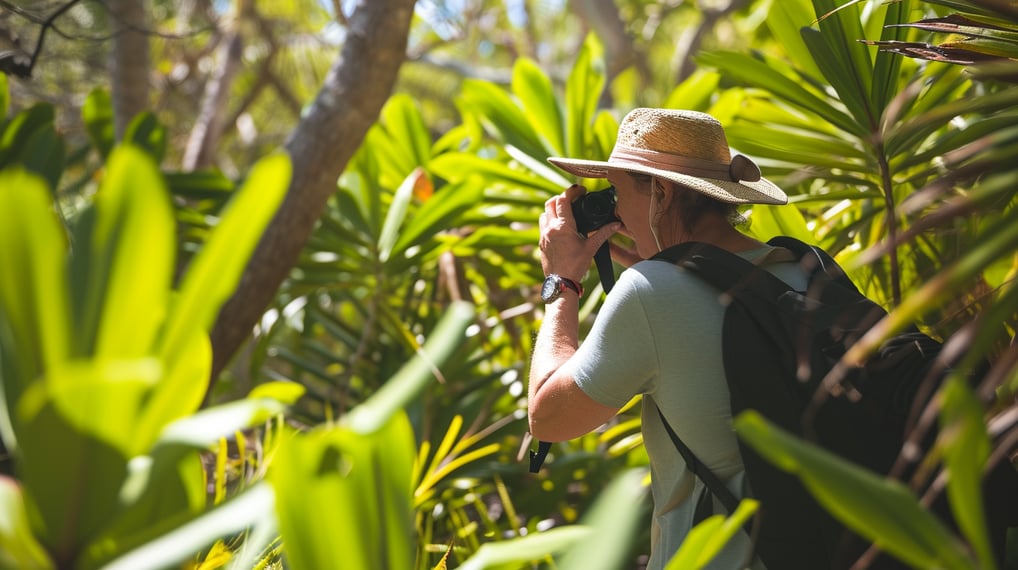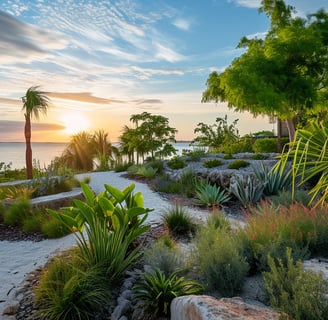Island Flora: Exploring the Botanical Beauty of Private Islands
Delve into the lush world of island flora, where private islands reveal their botanical beauty, showcasing many exotic plants, vibrant flowers, and unique ecosystems in secluded paradises.

Understanding Island Flora
When we talk about island flora, it is important to first define what exactly we mean by this term. Island flora refers to the plant life that thrives on private islands, which are typically characterized by their geographical isolation, favorable climates, and unique ecosystems. These islands provide an ideal environment for the growth and diversification of plants, resulting in a stunning botanical display that distinguishes them from mainland landscapes.
But what sets island flora apart from other forms of vegetation? The answer lies in its unique characteristics.
Defining Island Flora
Island flora is comprised of plant species that have adapted to the specific conditions found on private islands. These conditions often include abundant sunlight, ample rainfall, fertile soil, and limited competition from other plant species. As a result, island flora tends to be exceptionally diverse, with a wide array of colors, shapes, and sizes.
Private islands offer a haven for plant life, where they can flourish without the pressures of intense competition. The abundance of sunlight provides the energy needed for photosynthesis, allowing plants to grow and thrive. The ample rainfall ensures a constant water supply, promoting healthy growth and development. The fertile soil, enriched with nutrients, provides a nourishing foundation for plants to anchor their roots and absorb essential minerals.
With limited competition from other plant species, island flora has the opportunity to spread its roots and explore various ecological niches. This freedom allows for the evolution of unique plant adaptations, resulting in a breathtaking display of botanical diversity.
The Unique Characteristics of Island Flora
One of the most remarkable features of island flora is its endemism. Endemism refers to the phenomenon where plant species are found exclusively on a particular island or group of islands. This means that each private island can boast its own distinctive plant life, found nowhere else on Earth. It's like discovering a secret garden suspended in time and space.
Imagine walking through a private island, surrounded by a tapestry of plants that exist nowhere else in the world. Each step reveals a new species, a new color, a new shape. The exclusivity of island flora adds an element of mystery and wonder to these botanical treasures.
Furthermore, island flora often showcases an impressive array of adaptive strategies. With limited resources and intense competition, plants on private islands have developed unique survival mechanisms such as drought tolerance, the ability to grow in nutrient-poor soils, and even symbiotic relationships with other organisms.
These adaptive strategies are a testament to the resilience and ingenuity of island flora. In the face of adversity, these plants have found innovative ways to thrive and survive. They have learned to conserve water during periods of drought, tapping into hidden reservoirs deep within the soil. They have adapted their root systems to extract nutrients efficiently from nutrient-poor soils, ensuring their continued growth and development. They have even formed symbiotic relationships with other organisms, such as insects or birds, to aid in pollination or seed dispersal.
Exploring the world of island flora is like embarking on a journey of discovery. It is a chance to witness the beauty and resilience of nature in its purest form. Each private island holds a treasure trove of botanical wonders, waiting to be explored and appreciated.

The Role of Climate in Shaping Island Flora
Now that we have a better understanding of island flora, let's explore how climate plays a pivotal role in shaping these botanical wonders.
Tropical Islands and Their Lush Vegetation
In the tropical regions of the world, where temperatures remain consistently warm throughout the year, private islands boast an abundance of lush vegetation. Think palm trees swaying in the breeze, vibrant orchids adorning tree trunks, and colorful bromeliads creating a vibrant tapestry of flowers. Countries like Fiji, the Maldives, and the Seychelles are renowned for their tropical island flora, attracting visitors from all corners of the globe.
The warm and humid climate of tropical islands provides the perfect conditions for a diverse range of plant species to thrive. The high temperatures and ample rainfall create a lush and verdant environment, where plants compete for sunlight and nutrients. This competition has led to the evolution of unique adaptations, such as large leaves to capture as much sunlight as possible, and deep root systems to access water deep within the soil.
One iconic example of tropical island flora is the coconut palm. These majestic trees not only provide shade and beauty but also serve as a vital resource for island communities. Coconuts are a staple food source, and their husks and leaves are used for various purposes, from building materials to crafts.
Another fascinating aspect of tropical island flora is the symbiotic relationships between plants and animals. Many tropical islands are home to a wide range of pollinators, such as butterflies, bees, and birds. These creatures play a crucial role in the reproduction of plant species, ensuring their survival and contributing to the overall biodiversity of the island.
The Hardy Flora of Temperate Islands
On the other hand, temperate islands, such as those found in coastal areas of the Mediterranean or the Pacific Northwest, have their own unique brand of flora. These islands are characterized by milder climates, cooler temperatures, and distinct seasonal changes. Here, you'll find hardy evergreen forests, charming wildflowers, and aromatic herbs that thrive in the temperate island environment.
The temperate climate of these islands presents a different set of challenges and opportunities for plant life. The cooler temperatures and seasonal variations require plants to adapt to changing conditions. Evergreen trees, such as pine and oak, dominate the landscape, providing a year-round green canopy. These trees have developed strategies to withstand cold winters, including thick bark and needle-like leaves that minimize water loss.
One notable example of temperate island flora is the heather found in the Scottish islands. These hardy shrubs thrive in the acidic soils and windy conditions, creating a stunning purple carpet across the landscape. Heather plays an essential role in the ecosystem, providing shelter and food for various animal species, including birds and insects.
Temperate islands also offer a rich variety of wildflowers, which burst into bloom during the spring and summer months. Delicate bluebells, vibrant daisies, and fragrant lavender are just a few examples of the colorful tapestry that adorns these islands. These wildflowers not only add beauty to the landscape but also attract pollinators, contributing to the overall health and diversity of the island ecosystem.
Whether it's the lush vegetation of tropical islands or the hardy flora of temperate islands, the role of climate in shaping island flora is undeniable. From the adaptations of plants to the symbiotic relationships with animals, the intricate web of life on these islands is a testament to the power of nature's influence.
The Influence of Isolation on Island Flora
Another key factor in the development of island flora is the isolation of private islands. This isolation creates a distinct and insular environment, which leads to fascinating evolutionary processes among plants.
The Concept of Endemism
Isolation often results in endemic species, which are plants that are found exclusively on a particular island or group of islands. This means that the development of these species has occurred in isolation from mainland species, fostering the creation of unique genetic traits. Examples of endemic island flora can be found on the Galapagos Islands, Hawaii, and the Canary Islands.
How Isolation Leads to Unique Plant Species
Isolation not only promotes genetic diversity but also allows plants to adapt and evolve in response to their specific island environment. Over time, these adaptations can result in the emergence of new species, further enhancing the botanical diversity and ecological significance of private islands.

The Impact of Human Activity on Island Flora
While private islands offer a haven for island flora, human activity can pose significant challenges to these delicate ecosystems.
The Effects of Tourism on Island Ecosystems
The allure of private islands attracts tourists from around the world, but this influx of visitors can have detrimental effects on the local flora. Trampling on sensitive vegetation, invasive species brought in unintentionally, and excessive resource consumption all pose threats to the survival of island species. Proper management and sustainable tourism practices are crucial for protecting the fragile balance of island flora.
Conservation Efforts to Protect Island Flora
To preserve the botanical beauty of private islands, dedicated conservation organizations and local communities are working tirelessly to protect and restore native vegetation. Efforts include the removal of invasive species, reforestation initiatives, and raising awareness about the importance of preserving these unique ecosystems. Places like the Galapagos National Park in Ecuador and the Gomera Biosphere Reserve in Spain are shining examples of successful conservation projects.
The Aesthetic Appeal of Island Flora
Beyond their ecological significance, island flora possesses a visual and sensory allure that captivates the hearts and minds of those who experience it firsthand.
The Visual Beauty of Island Plants
From the vibrant hues of tropical blooms to the tranquil greens of temperate foliage, island plants offer a feast for the eyes. Whether it's strolling through the manicured gardens of a luxury island resort or diving into a kaleidoscope of coral reefs teeming with marine life, the visual beauty of island flora leaves an indelible impression.
The Sensory Experience of Island Flora
But island flora is not just about visual aesthetics. It's a multi-sensory experience. The intoxicating scent of frangipani blossoms at sunset, the soft rustle of palm leaves in the ocean breeze, and the delicate touch of moss on ancient stone paths all contribute to an immersive encounter with the natural world.
As we conclude our exploration of the botanical beauty of private islands, we invite you to seek out these hidden paradises for yourself. Whether it's a luxurious retreat in the Maldives, an eco-friendly bungalow in Belize, or an adventurous expedition to the Galapagos Islands, there is a private island experience waiting to enchant you. Immerse yourself in the vibrant colors, soothing scents, and awe-inspiring diversity of island flora. Let the beauty of these botanical havens captivate your senses and leave you with memories that will last a lifetime.